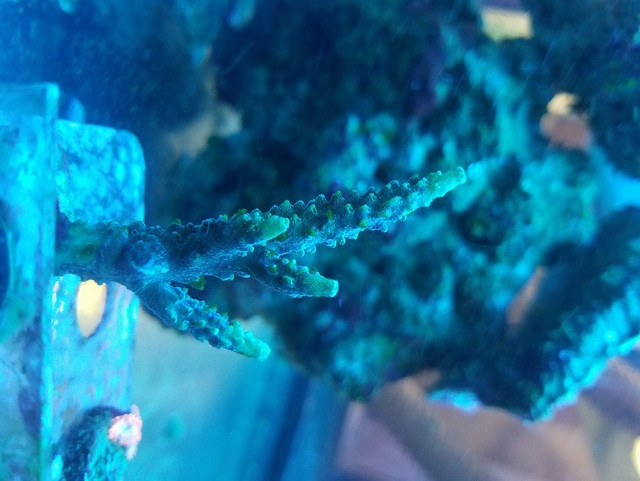ColtonMeng
New member
Hey folks,
I'll apologize ahead of time for the monologue - I'd rather give too much info than too little, to rule out all the typical culprits.
After shutting down my home tank and setting up my work tank, I've run into issues for approaching two years that will not allow me to maintain an SPS reef tank. I've been in the trade long enough to think I know what I'm doing, but apparently not long enough to actually know what I'm doing. I'd love any feedback you can provide on why I constantly have a very slow STN on any SPS added / LPS never "pop" like they should, albeit seemingly never do much. Zoanthids and anemone's grow well.
Tank - inception in early 2016. 220 gallon setup, dual durso'ed with separate siphon / solenoid valve to control any potential gurgle. Separate closed loop currently not running. 50 gallon custom sump. Bare bottom tank.
Rock from prior setup, cleaned with HCL 20 baume, neutralized, rinsed, and added.
Equipment: UV sterilizer. GFO / carbon reactor (not running atm). Reef Octopus skimmer.
Additives: none, outside of mag/alk/cal on a GHL peristaltic doser; until I started getting frustrated around the 1.5 year mark. Acro Power / NaNO3 dosed to no change in effect over the past two months.
Lighting - 8 x 80W ATI, 4x coral+ / 4x blue+. 4 bulb ramp up 1.5Hr, 8 bulb full 5Hr, 4 bulb ramp down 1.5Hr. Coral placement throughout with no noticeable variation in lifespan.
Fish - Tangs, a few blenny's and a clown.
Typical testing parameters, averaged due to no massive changes (except for a few hiccups) over 12+ months:
Mag - 1500
Alk - 7.5-8.5
Cal - 420-450
Nitrate - 0* (until NaNO3 dosing, then stabilized 5PPM)
Phosphate - 0 (never a discernible result)
Test kits-
salifert, outside of Red Sea for nitrate and colorimeters whenever possible. All reagents refreshed numerous times to rule out potential issues with testing.
My guess - I've gone by the adage "horses before zebras" forever. At this point I'm of the opinion I've ruled out any potential culprit several times over, without finding the true issue. My only thought at this point is plumbing hosing, of which I'm using pool grade material. I've read through so many of Randy's documents (and others) that my mind is beginning to dream about Redfield Ratio's and Shrimp (don't ask - some random study).
Any and all suggestions will be greatly appreciated. I'd give anything to solve this bloody issue.
Colton
For what it is worth - my prior tank grew SPS with a fervor.
I'll apologize ahead of time for the monologue - I'd rather give too much info than too little, to rule out all the typical culprits.
After shutting down my home tank and setting up my work tank, I've run into issues for approaching two years that will not allow me to maintain an SPS reef tank. I've been in the trade long enough to think I know what I'm doing, but apparently not long enough to actually know what I'm doing. I'd love any feedback you can provide on why I constantly have a very slow STN on any SPS added / LPS never "pop" like they should, albeit seemingly never do much. Zoanthids and anemone's grow well.
Tank - inception in early 2016. 220 gallon setup, dual durso'ed with separate siphon / solenoid valve to control any potential gurgle. Separate closed loop currently not running. 50 gallon custom sump. Bare bottom tank.
Rock from prior setup, cleaned with HCL 20 baume, neutralized, rinsed, and added.
Equipment: UV sterilizer. GFO / carbon reactor (not running atm). Reef Octopus skimmer.
Additives: none, outside of mag/alk/cal on a GHL peristaltic doser; until I started getting frustrated around the 1.5 year mark. Acro Power / NaNO3 dosed to no change in effect over the past two months.
Lighting - 8 x 80W ATI, 4x coral+ / 4x blue+. 4 bulb ramp up 1.5Hr, 8 bulb full 5Hr, 4 bulb ramp down 1.5Hr. Coral placement throughout with no noticeable variation in lifespan.
Fish - Tangs, a few blenny's and a clown.
Typical testing parameters, averaged due to no massive changes (except for a few hiccups) over 12+ months:
Mag - 1500
Alk - 7.5-8.5
Cal - 420-450
Nitrate - 0* (until NaNO3 dosing, then stabilized 5PPM)
Phosphate - 0 (never a discernible result)
Test kits-
salifert, outside of Red Sea for nitrate and colorimeters whenever possible. All reagents refreshed numerous times to rule out potential issues with testing.
My guess - I've gone by the adage "horses before zebras" forever. At this point I'm of the opinion I've ruled out any potential culprit several times over, without finding the true issue. My only thought at this point is plumbing hosing, of which I'm using pool grade material. I've read through so many of Randy's documents (and others) that my mind is beginning to dream about Redfield Ratio's and Shrimp (don't ask - some random study).
Any and all suggestions will be greatly appreciated. I'd give anything to solve this bloody issue.
Colton
For what it is worth - my prior tank grew SPS with a fervor.


